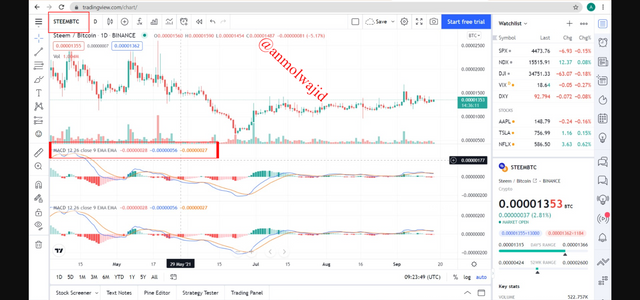Technical indicators - Crypto Academy / S4W2- Homework Post for @reminiscence01
Explain Technical indicators and why it is a good technical analysis tool.
Example

How technical indicators are a good analysis tool?


Are technical indicators good for cryptocurrency analysis? Explain your answer.

For example, an RSI reading is incomplete without using it in conjunction with price action. RSI tends to move in cycles when used over time. If the indicator is above 80 the trend will be up or bullish when it falls below 20, the trend will be down or bearish. This coincides with the price trend in many cases but in others they are different. It depends on your patience and trading style to determine which one works best for you. While it is important to know about indicators for trading there are some that you can ignore or not pay much attention too. For example, if you are trading small cap coins it is best to focus on volume indicators like the Bollinger bands rather than indicators like MACD.
In conclusion, technical analysis can be very helpful for trading cryptocurrencies. It helps to predict the trend after long periods of time to get a better idea of what to expect.

Illustrate how to add indicators on the chart and also how to configure them. (Screenshot needed).

- Visit the Link https://www.tradingview.com/
- Clicking on the chart; as shown in the screenshot
Source
Will take the user to a new screen where different chart customization options will be available. - When the page is visited clicking on the top menu; a new popup is shown
Source
Clicking on any of the suggested Search result will select that one chart - Clicking on the Fx icon will open up a new window where we can have plenty of options to choose an indicator from.
Source - Clicking on name of anyone of the indicator will open up results for the same pair.
Source

Explain the different categories of Technical indicators and give an example of each category. Also, show the indicators used as an example on your chart.

Technical indicators are commonly known to represent market sentiment, which is why they are so important in the realm of technical trading. Technical indicators are calculated by analyzing price movements, volume, and open interest. It is important to remember that this data alone does not dictate the market direction.
Main categories of technical indicators are; Trend Based Indicators, Volatility Based Indicators and Momentum-Based Indicators, I will explain each one with an example.
Trend Based Indicators:
Trend based indicators are calculated by analyzing the direction of a price move over a short period of time. Some tools calculate a trend-based indicator by looking at a moving average of a long-term trend, while others use the average of the last 3-5 period highs and lows. There are also trend based indicators that look at using closing prices instead of highs and lows.
Example of Trend Based indicators
ADX:
The ADX line indicates the strength of the trend, and moves from 0-100. It starts at 100 when the security is moving in an upward trend and moves towards 0 as the security moves through a downward trend. ADX gives you a sense of how fast price trades in relation to its underlying support or resistance. The ADX line that rises with a supporting price level means that there are no obstacles on the way up and that there is confidence for more increase in prices. The ADX line that heads down with supporting prices means there might be some obstacles on its way up and this might hinder further movement of prices upwards.
Volatility based indicators:
Volatility based indicators work to predict future volatility. This category of indicators is very useful for understanding bitcoin volatility patterns. Volatility based indicators can be calculated by looking at the Commodity Channel Index (CCI), the Average True Range (ATR) and Bollinger Bucks.
Example of Volatility based Indicator
Commodity Channel Index: The Commodity Channel Index (CCI) measures market volatility by using a single-period exponential moving average of the absolute value of commodity futures' price movements from a standard baseline, typically from one day to 50 days.
Momentum based indicators:
Momentum based indicators work to predict future momentum. This category of indicators is very useful for understanding bitcoin momentum patterns. There are many different types of momentum based indicators, such as MACD, Relative Strength Index (RSI), and the Ultimate Oscillator.
Examples of Momentum based indicators
MACD: The Moving Average Convergence Divergence (MACD) is technical indicator that shows market momentum by using moving averages of prices over different time periods. The MACD is calculated by subtracting the 26-day exponential moving average from a 12-day exponential moving average of a security's price. Traders will often use this divergence to predict the direction of future prices.
.png)

Indicators as standalone tools


The best way to use indicators is through cross-sectional analysis while planning trade strategies.
How an investor can increase the success rate of a technical indicator signal?

Investors are always on the lookout for profitable investments, and technical indicators can help them increase their chances. For instance, technical indicators will identify trends before they happen. Technical indicators are found in chart patterns, but more specifically in momentum indicator signals. A momentum indicator is a type of technical indicator that measures the speed and direction of price movement over time. Momentum is calculated by subtracting a previous close from a current close to get the difference between two closes that move in opposite directions.
Momentum indicators track the rate at which prices are moving. Momentum is gauged by subtracting a previous close from a current close to see if prices are moving higher in an upward trend or lower in a downward trend. When momentum is in an upward trend, it means that the difference in price opens up between two opens. This creates the positive divergence necessary to confirm a valid buy signal. The value of momentum can be increased by decreasing the amount of data used to find clues. For instance, using only daily closes rather than monthly closes will improve consistency and coherence. By using daily closes, the indicators will be more accurate at identifying trends.
It is important to note that momentum is not technically true momentum; it is simply a shortcut way to calculate trend. It's like taking the average of two security prices over time and saying that the security is moving upward. What makes momentum statistically significant is its ability to make accurate predictions; it eliminates random price movements during volatile markets. This means that investors can reduce their overall investment risk by monitoring momentum signals because they know that the indicator's accuracy depends on the strength of support and resistance points. If an investor becomes unhappy with an indicator signal or if two signals contradict each other, it may be real momentum coming into play rather than just an inaccurate technical indicator signal.
In conclusion i would say to increase success rate of a technical indicator signal look for less noise and more signals by using a broader range of indicators.

.png)
.png)
.png)
.png)
.png)
.png)

Hello @anmolwajid, I’m glad you participated in the 2nd week Season 4 of the Beginner’s class at the Steemit Crypto Academy. Your grades in this task are as follows:
Recommendation / Feedback:
Thank you for submitting your homework task.
Thanks @reminiscence01
@reminiscence01 post has reached its 5th day, please send curator vote